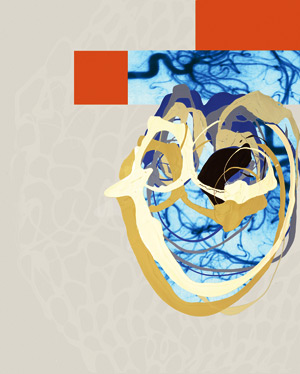Berkeleyan
National Academy of Sciences hosting art-practice prof Katherine Sherwood's 'Golgi's Door' show
![]()
| 13 February 2008
The paintings and prints by art-practice professor Katherine Sherwood on display through Feb. 22 in the National Academy of Sciences' Rotunda Gallery in Washington, D.C., contrast historic and contemporary medical imaging with ancient symbols of magic, mystery, and healing from around the globe.
 Cajal's Revenge, 2007, mixed media on canvas, 64x50 inches (Courtesy of Katherine Sherwood, Gallery Paule Anglim, and Hemphill Gallery) |
A visual commentary on the intersection of medicine and art, the exhibit is titled "Golgi's Door" in recognition of Camillo Golgi, a 19th-century Italian physician and scientist who won the 1906 Nobel Prize in Medicine. Golgi developed a path-breaking method of staining nerve tissues that made the brain's complex networking structure more visible and expanded understanding of the human nervous system.
Sherwood said her art's many influences include Golgi's discoveries and related sketches, neuro-anatomical prints made by Belgian anatomist and physician Andreas Vesalius in the 16th century, and even angiograms taken of her own brain after she suffered a cerebral hemorrhage in 1997.
The names of Sherwood's paintings in the Washington exhibit tell their own stories: Pump, Drug, Computers, Shape of People, CIA Genes, and Golgi's Door.
In an essay in the "Golgi's Door" exhibit catalog, Berkeley professor of English Georgina Kleege wrote: "Katherine Sherwood's work invites us to think about thinking, to meditate on the brain, its form, its contents, and the many ways artists, scientists, and magicians have sought to map and harness its powers. It is intensely cerebral work, on both the figurative and literal levels. It makes us mindful of the brain as the site of ideas, imagination, memory, and dreams. But it is also a fleshly thing, made of tissue, fueled by blood, heir to mishap, and yet capable of renewal and change."
In his essay for the catalog, neurologist Anjan Chatterjee expressed interest in the biological underpinnings of art and creativity and his captivation by Sherwood's art.
 Transports Instantaneously, 2007, mixed media on canvas, 72x72 inches (Courtesy of Katherine Sherwood and Electric Works) |
"The paintings loom large and the viewer can easily get lost in them," he wrote. "Forms flow to the edge of the canvasses..Nestled within these organic forms, mechanical shapes also are present. Some of the objects depicted are known. Others feel familiar but are not quite recognizable. Still others feel alien. The compositions are generally flat. But they also are layered with history, biology, and even magic."
Sherwood won the 1999 Adeline Kent Award from the San Francisco Art Institute. More recently she received a 2005-06 Guggenheim Fellowship and a 2006-07 Joan Mitchell Foundation grant.
The New Orleans native exhibits her work across the country, often holding shows in California. In 2000 her work was included in the Whitney Museum of American Art's Biennial Exhibition in New York City.
Sherwood's work has previously been featured in "Visionary Anatomies," a 2005-07 National Academy of Sciences exhibit of the work of artists who use anatomical images and concepts to express social, cultural, and aesthetic ideas.
Her work also was displayed in "Inside Out Loud: Visualizing Women's Health in Contemporary Art" at the Mildred Lane Kemper Art Museum at Washington University in St. Louis, Mo., and "Human Being" at the Chicago Cultural Center. Sherwood co-curated the 2005 exhibition "Blind at the Museum" at the Berkeley Art Museum, where she organized an accompanying conference.

